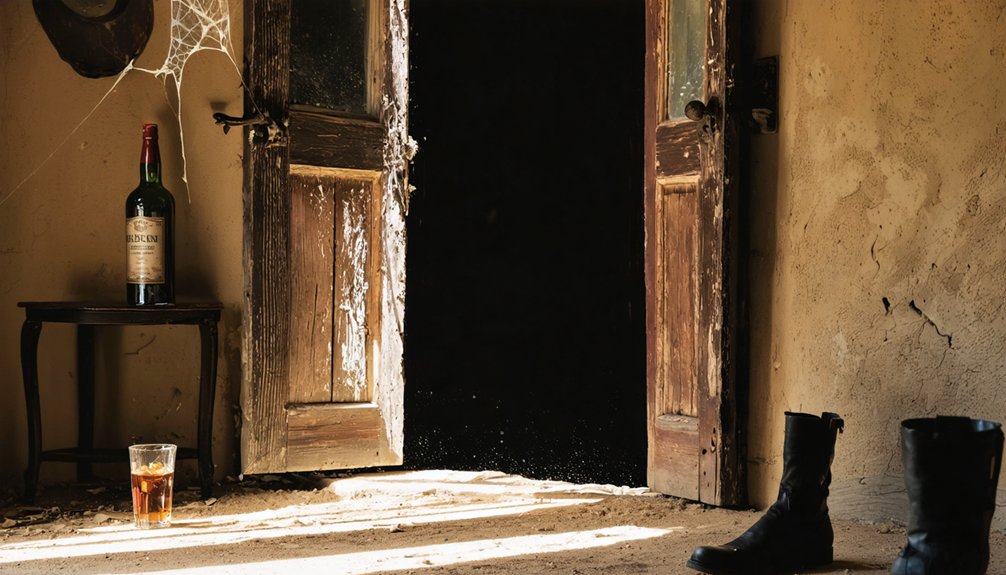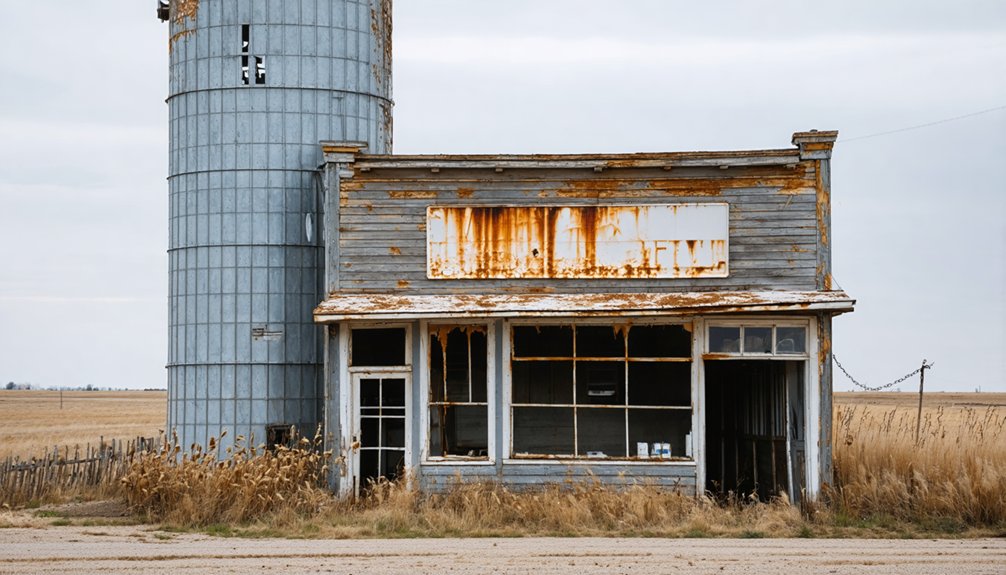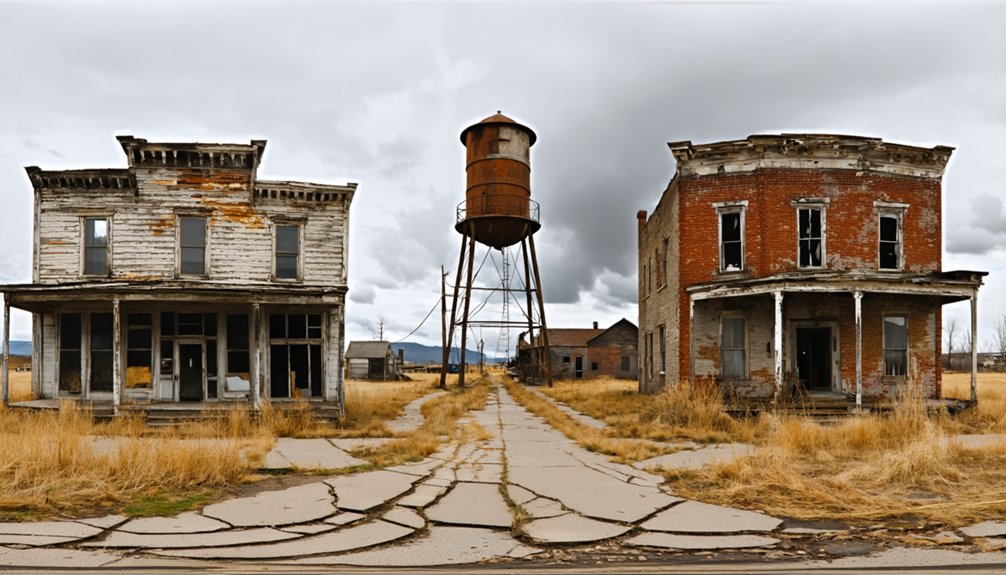When exploring Wild West ghost towns, you’ll need to research each town’s unique history, pack sturdy boots and safety gear, and respect property boundaries. Always carry water, navigation tools, and emergency supplies for remote locations. Visit during golden hours for ideal photography, and document weathered details that tell authentic stories. Practice “Leave No Trace” ethics by never removing artifacts or disturbing structures. Venture beyond main streets to discover the hidden narratives that reveal a town’s true character.
Key Takeaways
- Research the ghost town’s history before visiting to understand its significance within broader Western expansion narratives.
- Bring appropriate safety gear including sturdy boots, first aid kits, and navigation tools like GPS and paper maps.
- Respect private property by verifying access rights and obtaining necessary permissions before exploring abandoned sites.
- Practice “Leave No Trace” ethics by never removing artifacts, disturbing structures, or leaving behind trash.
- Document your experience thoughtfully by photographing during golden hours and capturing details that tell authentic stories about former inhabitants.
Research the Ghost Town’s Specific History Before Visiting
Before starting your expedition to a Wild West ghost town, thoroughly researching its specific history proves essential for a meaningful and informed experience. Investigate whether the town emerged from mining booms, railroad development, or agricultural endeavors to understand its rise and eventual abandonment.
This knowledge illuminates the architectural styles you’ll encounter and explains unique layout features that served specific historical functions.
Identify key historical figures connected to the site and how the town fits into broader national narratives like westward expansion. Understanding its historical significance within regional development provides context for artifacts you’ll observe.
Ghost towns whisper forgotten stories of pioneers who shaped America’s frontier and quietly faded into history.
Each abandoned settlement serves as a time capsule of the era when it thrived, preserving elements of daily life from a bygone time.
This preparation transforms your visit from mere sightseeing into a deeper appreciation of how these settlements contributed to America’s development and why they were ultimately left behind. Many ghost towns date from the 1880-1940 period of westward expansion and industrialization.
Pack Essential Gear for Remote Exploration
While historical knowledge prepares your mind for ghost town exploration, physical preparation demands equal attention. Your gear essentials should prioritize protection, navigation, and sustenance in these remote locations.
Equip yourself with sturdy hiking boots and layered clothing to navigate uneven terrain and unpredictable weather. Don’t underestimate the importance of dual light sources—headlamps free your hands while exploring dark structures. GPS devices and paper maps are essential, as cell service typically disappears in these isolated areas.
Your packing strategies should include safety equipment like first aid kits, dust masks, and protective eyewear. Plan for hydration by carrying at least one liter of water per few hours, supplemented with energy-dense snacks. Always carry three days’ worth of water and food supplies in case you become stranded in these remote locations. Consider bringing a quality infrared camera for capturing potential paranormal activity in the darkness of abandoned buildings without disturbing the atmosphere with flash photography.
Documentation tools—cameras, notebooks, and backup power—ensure you’ll capture discoveries while maintaining your freedom to explore these forgotten frontiers.
Respect Local Regulations and Property Boundaries
Although ghost towns beckon with their mysterious allure, traversing the legal landscape surrounding these abandoned settlements requires careful consideration of ownership rights and regulatory frameworks.
Remember that many ghost towns sit on private property, not public land, making verification of access rights essential before your expedition.
Always respect property rights by heeding posted signs, avoiding fenced areas without permission, and contacting local authorities when ownership seems unclear. Local laws, including zoning regulations, may restrict activities even in seemingly abandoned locations. Municipal websites typically provide this vital information.
When exploring, inform someone of your planned route, practice “leave no trace” principles, and never remove artifacts.
Multiple landowners might control different sections of a single ghost town, so thorough research beforehand protects both you and these historically significant sites from legal complications. Visit during daylight hours only to maximize safety and visibility while navigating unfamiliar terrain. Historical sites may also be subject to restrictive covenants that limit certain activities to preserve their authentic character.
Plan Your Visit During Optimal Weather Conditions
The weather’s mercurial nature across the Wild West‘s vast, unpredictable terrains can transform a ghost town expedition from an enlightening adventure into a perilous ordeal.
Mother Nature’s fickle temperament can quickly turn Wild West exploration from discovery to danger.
Understanding seasonal weather patterns empowers you to navigate these historical treasures safely while maximizing your experience.
For ideal exploration conditions:
- Schedule visits between May and October – when sites are operational and roads remain accessible without specialized equipment.
- Target weekday mornings – reducing crowd density while capturing superior lighting for photography.
- Prepare for temperature fluctuations – layer clothing to accommodate the desert’s dramatic day-to-night shifts.
- Verify road conditions before departure – contact land management agencies for current access information, especially during changing seasons.
Proper seasonal preparation not only guarantees your safety but preserves these fragile historical environments from unnecessary wear during vulnerable weather periods.
Visitors to Bodie, California should prioritize summer and fall months when over 100 original structures remain accessible and provide the most authentic gold rush experience.
Similar to Kayaköy, Turkey, some Western ghost towns have seen recent restoration efforts introducing amenities like cafes and museums to enhance visitor experiences while preserving historical authenticity.
Document Your Experience With Thoughtful Photography
When photographing ghost towns, you’ll uncover profound historical narratives by focusing your lens on specific elements like weathered signage, discarded personal items, and architectural details that communicate the site’s abandoned past.
During golden hours, position yourself to exploit the interplay between light and shadow, allowing the low-angle illumination to accentuate textures on decaying structures and create dramatic silhouettes that reveal the town’s skeletal framework.
You can enhance your compositions by seeking less conventional angles—crouching low or positioning your camera through broken windows—to craft unique perspectives that distinguish your documentation from typical ghost town imagery. Before capturing your final shots, it’s advisable to spend time scouting the location to identify compelling compositions and understand how light changes throughout the day. Consider using long-exposure techniques to capture the ethereal quality of movement through abandoned spaces, creating a surreal beauty that connects past and present.
Capture Forgotten Stories
Documenting ghost towns through thoughtful photography requires more than simply pointing and shooting—it demands conscious preparation, technical skill, and ethical consideration to authentically capture forgotten narratives. Your images should evoke the ghostly ambiance while creating narrative composition that connects viewers with history.
To effectively capture these forgotten stories:
- Research each location’s unique history before arrival, identifying key structures that tell compelling stories about former inhabitants.
- Frame compositions through doorways and windows to create layered storytelling elements that suggest passage of time.
- Photograph during golden hours when natural light casts dramatic shadows that enhance mood and historical context.
- Preserve authenticity by avoiding staged shots and employing minimal editing that respects the site’s genuine character.
Remember that successful ghost town photography balances technical excellence with ethical documentation, preserving these fragile historical records for future generations.
Master Shadow Play
Shadows dance across weathered facades, transforming ordinary ghost town ruins into dramatic theaters of light and dark that reveal hidden narratives embedded within these abandoned spaces.
You’ll capture these ephemeral stories by mounting your camera on a tripod—essential for the long exposures that preserve shadow precision in low-light conditions.
Master shadow techniques by shooting during golden hour when angled sunlight casts dramatic shadows across decaying structures.
Experiment with light manipulation through flashlights and colored gels to selectively illuminate dark recesses while maintaining atmospheric shadow play.
Position yourself to use lattice shadows from broken windows as compositional elements, creating depth and visual intrigue.
Set your camera to manual focus with wider apertures (f/4) and longer exposures (10-30 seconds) to balance ambient shadow detail.
Shoot RAW to preserve shadow nuances for post-processing refinement.
To navigate the desolate remnants of America’s frontier past safely, thorough mapping strategies and reliable communication backups remain essential components of any ghost town expedition.
Proper map navigation requires layered redundancy—never rely solely on digital tools when exploring these isolated historical vestiges.
- Download offline maps before departure and carry physical maps as backup, particularly specialized ghost town guides that document structures now absent from standard cartography.
- Establish check-in protocols with a trusted contact, sharing your itinerary and expected return time.
- Pack communication tools beyond cell phones, such as satellite messengers or two-way radios for group exploration.
- Cross-reference multiple map sources to confirm locations, as ghost town coordinates are often ambiguous due to their abandoned status.
Look for Telltale Signs of the Town’s Former Purpose

When approaching a ghost town‘s weathered remains, experienced explorers look beyond the obvious ruins to identify distinctive architectural features and artifacts that reveal the settlement’s original economic foundation.
Mining indications are perhaps most telling—look for headframes towering above shaft entrances, scattered tailings piles, and abandoned ore carts. Towns built around extraction typically feature assay offices where precious metals were evaluated.
Headframes and tailings tell silent stories of fortune-seekers who once evaluated earth’s treasures in humble assay offices.
Railroad remnants offer different clues: search for depots, loading docks, or the subtle depression of former tracks where ties once lay. Wide main streets often accommodated rail traffic and related commerce.
Agricultural ghost towns reveal themselves through deteriorating barns, windmills, and irrigation systems.
Meanwhile, civic buildings like courthouses and jails signal administrative centers, while rows of small worker houses versus larger Victorian homes illustrate social hierarchies that once defined these vanished communities.
Connect With Local Historical Societies for Deeper Insights
Local historical societies represent invaluable resources that transform casual ghost town visits into profound historical explorations.
These organizations serve as repositories of primary sources—maps, diaries, and photographs—that reveal authentic narratives beyond surface-level observations. Through local engagement, you’ll gain access to preservation efforts that protect these fragile historical sites for future generations.
Consider these essential connections:
- Access archived materials containing firsthand accounts and detailed maps identifying significant structures
- Participate in ongoing restoration projects as a volunteer or observer
- Attend specialized guided tours revealing hidden stories and contextual understanding
- Network with local experts who can introduce you to descendants of original inhabitants
Preserve the Past by Practicing “Leave No Trace” Ethics

When exploring ghost towns, you’ll preserve history by adhering to “Leave No Trace” ethics that respect the stories these abandoned settlements still tell.
Photograph and document artifacts in their original locations rather than handling or removing them, which can irreparably damage fragile historical contexts that archaeologists and historians need intact.
Always pack out everything you bring in, including seemingly innocuous items like food wrappers and water bottles, as modern refuse diminishes the authentic historical atmosphere and degrades these cultural treasures for future visitors.
Respect Historical Artifacts
Preservation of historical artifacts remains paramount when exploring ghost towns of the American West, as each item tells a unique story about the lives and experiences of those who came before us.
The Archaeological Resources Protection Act of 1979 legally protects these remnants of history, with violations resulting in substantial fines or imprisonment. Ethical exploration requires you to respect the cultural heritage these artifacts represent.
When visiting ghost town sites, remember:
- Photograph artifacts instead of handling or removing them
- Report significant finds to local historical societies
- Never disturb burial sites or human remains
- Avoid metal detecting or digging without proper authorization
You’ll contribute to artifact preservation while avoiding legal consequences that can include hefty penalties.
Your responsible approach guarantees these historical treasures remain intact for future generations.
Document, Don’t Disturb
To effectively preserve ghost town heritage, adopting “Leave No Trace” ethics transforms you from a passive visitor to an active steward of history. Established in 1994, this ethical framework emphasizes documenting rather than disturbing—photograph structures, don’t touch them; observe artifacts, never pocket them.
Practicing cultural sensitivity means respecting site boundaries, obeying posted restrictions, and leaving gates as you found them. Fill any holes, avoid campfires outside designated areas, and never climb on fragile structures. These ethical practices maintain site integrity for future explorers.
Support preservation through volunteering or donations to historical societies. Report vandalism or illegal activity to authorities immediately.
Pack Out All Trash
Leaving nothing behind but footprints stands as a fundamental principle of ghost town stewardship. These fragile historical sites lack trash collection services, making your personal responsibility critical for both preservation and wildlife safety.
When degradable and non-degradable waste remains, it accelerates deterioration of irreplaceable structures and endangers local fauna that might ingest harmful materials.
To properly manage waste during your visit:
- Plan ahead to minimize packaging and single-use items
- Carry sealed bags for all waste, including food scraps and hygiene products
- Bury human waste in 6-8 inch catholes, 200 feet from water sources
- Inspect your area thoroughly before departing to guarantee complete cleanup
Your diligence in waste management supports sustainable tourism and preserves these authentic cultural landscapes for future explorers—maintaining both their historical integrity and environmental health.
Explore Beyond the Main Street for Hidden Stories
While most visitors to ghost towns focus their attention on prominent main street establishments like saloons and general stores, the richest historical narratives often lie in the peripheral zones that extend beyond these well-traveled thoroughfares.
Venture down side streets where working-class residents lived, revealing social hierarchies invisible from main attractions. These hidden narratives emerge when you explore abandoned churches, schoolhouses, and jails that tell stories of community life.
Explore beyond main streets to uncover the true social fabric woven through a ghost town’s forgotten corners.
Review historical maps before your visit to identify forgotten landmarks—mills, mines, and homesteads—that explain the town’s economic rise and fall.
Cemetery visits offer particularly poignant glimpses into personal histories. For the most authentic experience, seek permission to access off-grid sites with higher preservation levels, where you’ll discover untouched ruins that haven’t been polished for tourism, providing genuine insights into frontier life.
Frequently Asked Questions
How Dangerous Are Wildlife Encounters in Abandoned Ghost Towns?
Like shadows lurking in forgotten corners, wildlife encounters pose significant dangers. You’ll face unpredictable wildlife behavior from predators and disease carriers, requiring vigilant safety precautions including travel groups and deterrent equipment.
Can I Legally Take Small Artifacts as Souvenirs?
No, you can’t legally remove artifacts from ghost towns. Legal regulations explicitly prohibit souvenir collection on public lands, while private property requires owner permission. Artifact preservation is protected by federal and state laws.
Are Ghost Towns Accessible for Visitors With Mobility Limitations?
Most ghost towns present significant accessibility challenges. You’ll find limited wheelchair access on uneven terrain, though some managed sites offer guided tours accommodating mobility limitations. Research specific locations before visiting for accurate accessibility information.
How Do I Distinguish Between Authentic Ruins and Tourist Traps?
You’ll identify authentic ruins by examining historical significance markers, natural decay patterns, and minimal preservation efforts, whereas tourist traps feature commercial signage, staged elements, and excessive modern infrastructure designed for visitor convenience.
What’s the Etiquette for Encountering Other Explorers in Remote Locations?
The most essential expedition law: acknowledge others with friendly greetings but maintain distance. Exchange shared discoveries cautiously, respecting privacy. Use quiet communication, coordinate safety protocols, and never reveal exact locations publicly. Freedom demands mutual respect.
References
- https://devblog.batchgeo.com/ghost-towns/
- https://hiddenbritainse.org.uk/what-i-learned-from-ghost-town-exploration/
- https://www.raremaps.com/gallery/detail/63635
- https://m.dresshead.com/files/scholarship/Documents/Ghost_Towns_Lost_Cities_Of_The_Old_West_Shire_Usa.pdf
- https://www.newmexico.org/places-to-visit/ghost-towns/
- https://thewarriormuse.blogspot.com/2012/05/my-to-z-expedition-into-wild-west.html
- https://mapsofantiquity.com/products/1968-the-historic-west-lost-mines-and-ghost-towns-frontier-military-forts-pictorial-map
- https://climateviewer.org/history-and-science/ancient-ruins/maps/ghost-towns-of-america/
- https://www.frrandp.com/p/ghost-towns-map.html
- https://www.geotab.com/ghost-towns/



